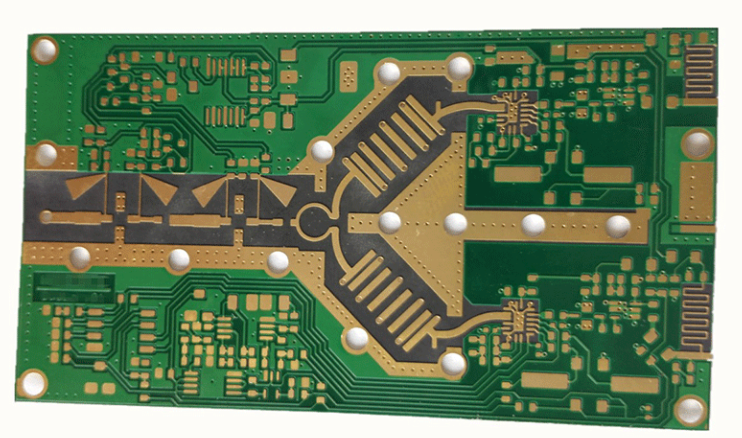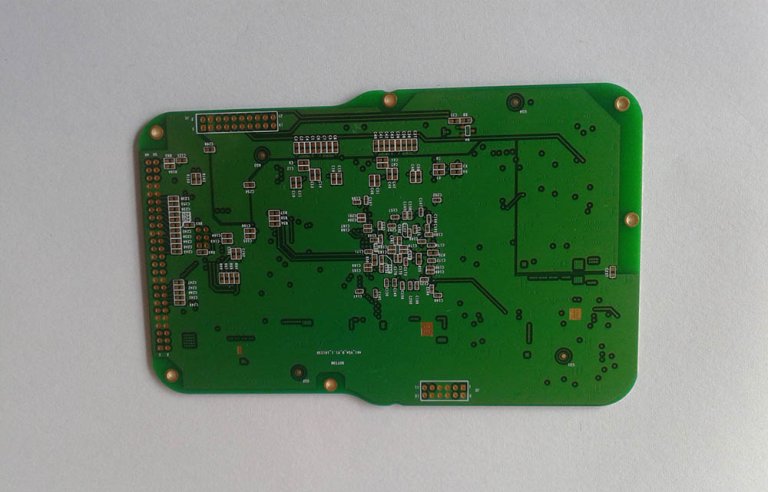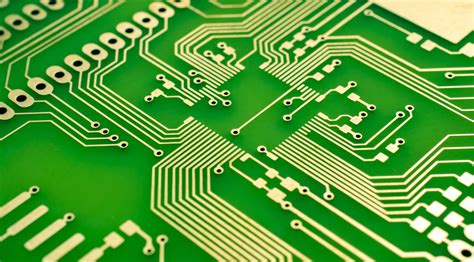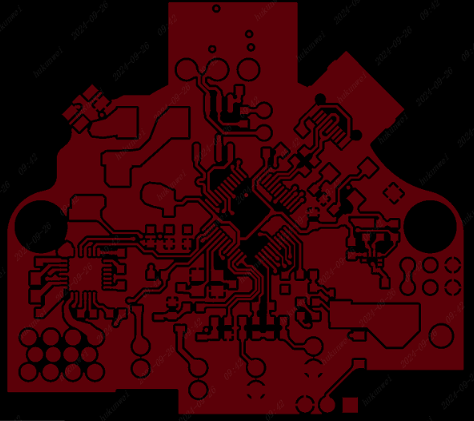Rogers 4350b pcb
Advantages Of Using Rogers 4350b PCB In High-Frequency Applications
Rogers 4350b PCB, a high-frequency laminate material, has garnered significant attention in the electronics industry due to its exceptional performance characteristics.
One of the primary advantages of using Rogers 4350b PCB in high-frequency applications is its low dielectric constant (Dk).
This property is crucial for maintaining signal integrity, as it minimizes signal loss and ensures consistent signal propagation. Consequently, devices that rely on high-frequency signals, such as RF and microwave circuits, benefit immensely from the stable and reliable performance offered by Rogers 4350b PCB.
In addition to its low dielectric constant, Rogers 4350b PCB exhibits a low dissipation factor (Df).
This attribute is particularly important in high-frequency applications where energy loss can significantly impact the efficiency and performance of the circuit. The low dissipation factor of Rogers 4350b PCB ensures that minimal energy is lost as heat, thereby enhancing the overall efficiency of the device. This characteristic is especially beneficial in applications such as satellite communications, radar systems, and wireless networks, where maintaining high efficiency is paramount.
Moreover, Rogers 4350b PCB offers excellent thermal management properties.
High-frequency applications often generate substantial amounts of heat, which can adversely affect the performance and longevity of electronic components. The thermal conductivity of Rogers 4350b PCB helps to dissipate heat effectively, thereby preventing overheating and ensuring the reliable operation of the device. This thermal management capability is particularly advantageous in applications that demand high power handling and thermal stability, such as power amplifiers and high-power RF circuits.
Furthermore, the mechanical stability of Rogers 4350b PCB is another significant advantage.
High-frequency applications often require precise and stable performance over a wide range of environmental conditions. Rogers 4350b PCB exhibits excellent dimensional stability, which ensures that the physical properties of the laminate remain consistent even under varying temperatures and humidity levels. This stability is crucial for maintaining the integrity of the circuit and preventing performance degradation over time.
Additionally, Rogers 4350b PCB is known for its ease of fabrication.
The material can be processed using standard PCB manufacturing techniques, which simplifies the production process and reduces costs. This ease of fabrication is particularly beneficial for high-frequency applications that require complex and intricate circuit designs. The ability to produce high-quality PCBs with minimal effort and expense makes Rogers 4350b PCB an attractive choice for designers and manufacturers alike.
Another noteworthy advantage of Rogers 4350b PCB is its compatibility with lead-free soldering processes.
As the electronics industry continues to move towards environmentally friendly practices, the use of lead-free soldering has become increasingly important. Rogers 4350b PCB is designed to withstand the higher temperatures associated with lead-free soldering, ensuring that the material remains reliable and robust throughout the manufacturing process. This compatibility with lead-free soldering further enhances the appeal of Rogers 4350b PCB for high-frequency applications.
In conclusion, the advantages of using Rogers 4350b PCB in high-frequency applications are manifold. Its low dielectric constant and dissipation factor ensure minimal signal loss and high efficiency, while its excellent thermal management properties prevent overheating. The mechanical stability of Rogers 4350b PCB guarantees consistent performance under varying environmental conditions, and its ease of fabrication simplifies the production process. Additionally, its compatibility with lead-free soldering processes aligns with the industry’s move towards environmentally friendly practices. These attributes collectively make Rogers 4350b PCB an ideal choice for a wide range of high-frequency applications, from satellite communications to wireless networks and beyond.

Design Tips For Optimizing Performance With Rogers 4350b PCB
When designing printed circuit boards (PCBs) with Rogers 4350b material, it is essential to consider several factors to optimize performance. Rogers 4350b is a high-frequency laminate known for its excellent electrical properties, making it a popular choice for RF and microwave applications. To fully leverage its capabilities, designers must pay close attention to various design aspects, including material selection, layer stack-up, trace width, and impedance control.
Firstly, understanding the material properties of Rogers 4350b is crucial.
This laminate offers a low dielectric constant (Dk) and low loss tangent, which are vital for maintaining signal integrity at high frequencies. The low Dk ensures minimal signal delay, while the low loss tangent reduces signal attenuation. Consequently, these properties make Rogers 4350b an ideal choice for high-speed digital and RF circuits. However, to maximize these benefits, designers must carefully select complementary materials for other layers in the PCB stack-up.
Transitioning to the layer stack-up, it is important to design a configuration that minimizes signal loss and crosstalk.
A well-planned stack-up can significantly enhance the performance of the PCB. For instance, placing ground planes adjacent to signal layers can provide effective shielding and reduce electromagnetic interference (EMI). Additionally, using multiple ground planes can help maintain a consistent reference plane, which is essential for impedance control. By strategically arranging the layers, designers can achieve a balance between performance and manufacturability.
Next, trace width and spacing play a pivotal role in optimizing PCB performance.
Rogers 4350b allows for tighter trace widths due to its superior thermal and mechanical stability. However, designers must ensure that the trace width is appropriate for the intended signal frequency. Narrower traces can lead to higher impedance, which may cause signal reflections and loss. Therefore, it is advisable to use simulation tools to determine the optimal trace width and spacing for the specific application. These tools can help predict the electrical behavior of the traces and ensure that they meet the desired performance criteria.
Impedance control is another critical aspect when working with Rogers 4350b PCBs.
Maintaining consistent impedance is essential for high-frequency signal transmission. Variations in impedance can lead to signal reflections, which degrade signal quality. To achieve precise impedance control, designers should use controlled impedance traces and consider factors such as trace width, spacing, and the dielectric constant of the material. Additionally, incorporating impedance matching techniques, such as using microstrip or stripline configurations, can further enhance signal integrity.
Moreover, thermal management is an often-overlooked aspect that can significantly impact PCB performance.
Rogers 4350b has excellent thermal properties, but designers must still account for heat dissipation in high-power applications. Implementing thermal vias, heat sinks, and proper ventilation can help manage heat effectively. By addressing thermal issues, designers can prevent overheating and ensure the long-term reliability of the PCB.
In conclusion, optimizing performance with Rogers 4350b PCBs requires a comprehensive approach that considers material properties, layer stack-up, trace width, impedance control, and thermal management. By paying attention to these design tips, engineers can fully exploit the advantages of Rogers 4350b and achieve superior performance in high-frequency applications. Through careful planning and the use of advanced simulation tools, designers can create PCBs that meet stringent performance requirements while maintaining reliability and manufacturability.

Comparing Rogers 4350b PCB To Other High-Frequency Materials
Rogers 4350b PCB is a high-frequency laminate material that has garnered significant attention in the electronics industry due to its exceptional performance characteristics. When comparing Rogers 4350b PCB to other high-frequency materials, several key factors come into play, including dielectric constant, thermal management, and signal integrity. Understanding these differences is crucial for engineers and designers who aim to optimize their electronic designs for high-frequency applications.
One of the primary attributes that set Rogers 4350b PCB apart from other high-frequency materials is its dielectric constant (Dk).
The dielectric constant of a material is a measure of its ability to store electrical energy in an electric field. Rogers 4350b PCB boasts a stable dielectric constant of 3.48, which is relatively low compared to other high-frequency materials. This stability is maintained over a wide range of frequencies and temperatures, making it an ideal choice for applications that require consistent performance. In contrast, other high-frequency materials may exhibit variations in their dielectric constant, leading to potential signal integrity issues and performance degradation.
Thermal management is another critical aspect where Rogers 4350b PCB excels.
High-frequency applications often generate significant amounts of heat, and effective thermal management is essential to ensure the reliability and longevity of electronic components. Rogers 4350b PCB has a low thermal coefficient of dielectric constant (TCDk), which means that its dielectric constant remains stable even as the temperature changes. This property is particularly advantageous in environments with fluctuating temperatures, as it helps maintain signal integrity and reduces the risk of thermal-induced failures. Other high-frequency materials may not offer the same level of thermal stability, potentially leading to performance inconsistencies and increased thermal stress on components.
Signal integrity is a paramount concern in high-frequency applications, and Rogers 4350b PCB provides superior performance in this regard.
The material’s low loss tangent, or dissipation factor, ensures minimal signal loss and distortion, which is crucial for maintaining the integrity of high-frequency signals. This low loss tangent is a result of the material’s unique composition, which includes a combination of ceramic-filled hydrocarbon and resin systems. In comparison, other high-frequency materials may have higher loss tangents, leading to greater signal attenuation and reduced overall performance.
Moreover, Rogers 4350b PCB offers excellent dimensional stability, which is essential for precise and reliable circuit fabrication.
The material’s low coefficient of thermal expansion (CTE) ensures that it maintains its dimensions even under thermal stress, reducing the risk of mechanical failures and ensuring consistent performance. This dimensional stability is particularly important in applications that require tight tolerances and high precision, such as aerospace and defense systems. Other high-frequency materials may exhibit higher CTE values, leading to potential issues with dimensional changes and mechanical reliability.
In addition to these technical advantages, Rogers 4350b PCB is also known for its ease of processing and compatibility with standard fabrication techniques.
This compatibility simplifies the manufacturing process and reduces production costs, making it an attractive option for a wide range of high-frequency applications. Other high-frequency materials may require specialized processing techniques, increasing complexity and cost.
In conclusion, when comparing Rogers 4350b PCB to other high-frequency materials, it becomes evident that its stable dielectric constant, superior thermal management, excellent signal integrity, and dimensional stability make it a standout choice for high-frequency applications. These attributes, combined with its ease of processing, position Rogers 4350b PCB as a preferred material for engineers and designers seeking to optimize their electronic designs for performance and reliability.

Manufacturing Challenges And Solutions For Rogers 4350b PCB
Rogers 4350b PCB, a high-frequency laminate material, is widely recognized for its superior performance in RF and microwave applications. However, manufacturing printed circuit boards (PCBs) using Rogers 4350b presents several challenges that require specialized solutions to ensure optimal functionality and reliability. One of the primary challenges in manufacturing Rogers 4350b PCBs is the material’s unique properties, which differ significantly from traditional FR-4 substrates. Rogers 4350b has a lower dielectric constant and dissipation factor, which are advantageous for high-frequency applications but necessitate precise control during the fabrication process. This precision is crucial to maintain the material’s electrical performance and to avoid signal loss or interference.
Another significant challenge is the thermal management of Rogers 4350b PCBs.
The material has a higher coefficient of thermal expansion (CTE) compared to FR-4, which can lead to issues such as delamination or warping during the soldering process. To address this, manufacturers must employ advanced thermal management techniques, such as using specialized solder masks and heat sinks, to dissipate heat effectively and maintain the structural integrity of the PCB. Additionally, the drilling process for Rogers 4350b PCBs requires careful consideration. The material’s hardness can cause excessive tool wear, leading to inaccuracies in hole dimensions and potential damage to the laminate. To mitigate this, manufacturers often use diamond-coated drill bits and employ controlled drilling speeds to ensure clean, precise holes. Furthermore, the use of laser drilling technology can enhance accuracy and reduce mechanical stress on the material.
The etching process also poses challenges due to the material’s chemical resistance.
Traditional etching solutions may not be effective, necessitating the use of specialized etchants and process controls to achieve the desired circuit patterns. Manufacturers must carefully monitor the etching process to prevent over-etching or under-etching, which can compromise the PCB’s performance. In addition to these technical challenges, the cost of Rogers 4350b material is higher than that of conventional FR-4. This cost factor necessitates efficient material utilization and waste reduction strategies during the manufacturing process. Manufacturers often employ advanced nesting techniques and optimize panel layouts to maximize material usage and minimize scrap.
Quality control is another critical aspect of manufacturing Rogers 4350b PCBs.
Given the material’s sensitivity to process variations, rigorous inspection and testing protocols are essential to ensure that the final product meets the required specifications. Techniques such as automated optical inspection (AOI), X-ray inspection, and electrical testing are commonly used to detect defects and verify the integrity of the PCB. Despite these challenges, several solutions have been developed to facilitate the manufacturing of Rogers 4350b PCBs. Advanced computer-aided design (CAD) software allows for precise modeling and simulation of the PCB layout, enabling manufacturers to identify potential issues and optimize the design before production. Additionally, continuous advancements in fabrication technology, such as improved drilling and etching equipment, have enhanced the accuracy and efficiency of the manufacturing process.
In conclusion, while the manufacturing of Rogers 4350b PCBs presents several challenges, these can be effectively addressed through a combination of advanced techniques, specialized equipment, and rigorous quality control measures. By understanding and mitigating these challenges, manufacturers can produce high-performance PCBs that meet the demanding requirements of RF and microwave applications, ensuring reliability and functionality in critical electronic systems.





